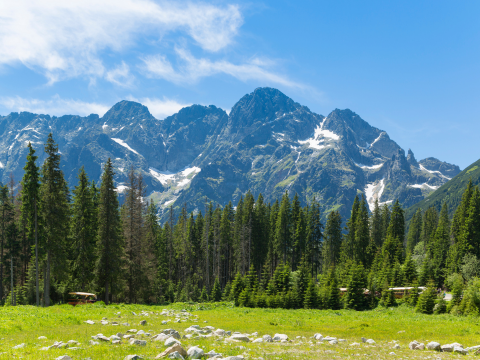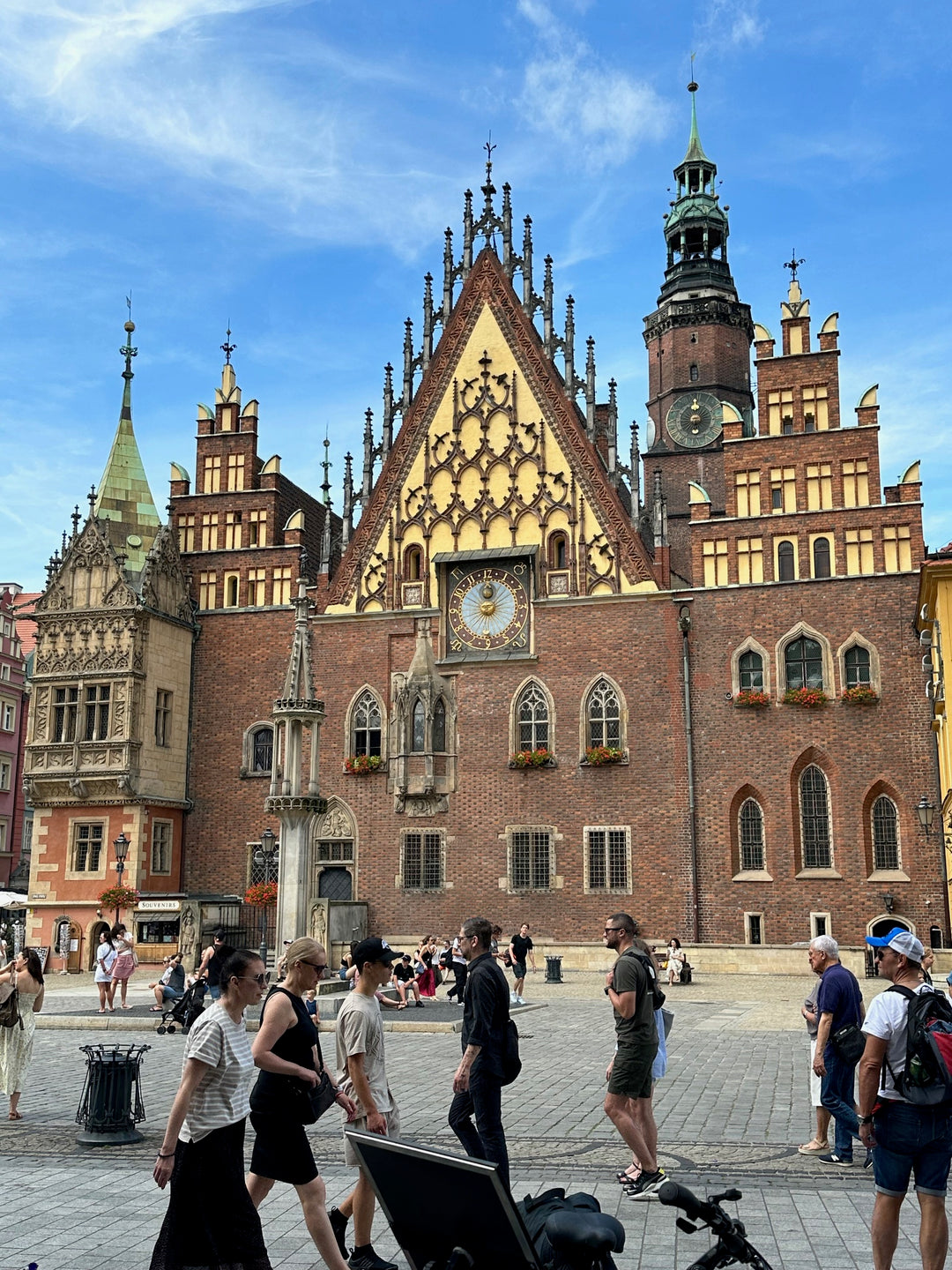5 Beautiful National Parks to Visit in Poland
5 Beautiful Places in Poland to Visit
Here are the top 5 stunningly beautiful national parks to visit in Poland. These natural wonders offer breathtaking landscapes and enchanting wilderness experiences, showcasing the diverse beauty of Poland's natural heritage. Please note that urban areas, towns, and villages are not included in this list.
Białowieża Forest
This ancient woodland is located on the border between Poland and Belarus and is home to the majestic European bison, making it a unique and beautiful destination. The Białowieża Forest is one of the last and largest remaining parts of the immense primeval forest that once stretched across the European Plain. It is a UNESCO World Heritage Site and a Biosphere Reserve, known for its exceptional biodiversity and natural beauty. Covering an area of over 1,500 square kilometers, the forest is a haven for wildlife. The European bison, also known as the wisent, is the most well-known and iconic resident of the forest. Once on the brink of extinction, careful conservation efforts have helped the population recover, with over 500 individuals now living in the forest.
Besides the European bison, the forest is also home to a wide range of other animal species, including lynx, wolves, wild boars, and various species of birds and insects. It is a paradise for nature lovers, offering numerous opportunities for hiking, birdwatching, and wildlife photography.
The forest itself is incredibly old, with some parts estimated to be over 10,000 years old. Walking through this ancient woodland, visitors can experience a sense of timelessness and connect with nature in a truly immersive way. The diverse ecosystem includes both pristine old-growth forests and more managed areas with centuries-old trees.

Visitors to the Białowieża Forest can explore the forest on guided tours or through self-guided hikes along marked trails. There are also several visitor centers and educational exhibits where visitors can learn about the forest's history, ecology, and ongoing conservation efforts.
In addition to its natural wonders, the Białowieża Forest also holds cultural significance. It has been a site of spiritual and cultural importance for centuries, with ancient rituals and traditions associated with the forest. Today, the area is a popular destination for ecotourism and offers a chance to experience the harmonious coexistence of humans and nature.
Overall, the Białowieża Forest is a unique and beautiful destination that provides a glimpse into Europe's rich natural and cultural heritage. It offers a rare opportunity to witness the majesty of the European bison in its natural habitat and connect with the ancient roots of the continent's wilderness.
The Białowieża Forest is an ancient woodland located on the border between Poland and Belarus. It is known for being one of the last and largest remaining parts of the primeval forest that once covered the European Plain. The forest is a UNESCO World Heritage Site and a Biosphere Reserve, recognized for its exceptional biodiversity and natural beauty. The European bison, also known as the wisent, is the most famous resident of the forest, with over 500 individuals living there. The forest is also home to other animal species such as lynx, wolves, wild boars, and various birds and insects. Visitors can enjoy activities like hiking, birdwatching, and wildlife photography. The forest is incredibly old, with some parts estimated to be over 10,000 years old, offering a sense of timelessness and a deep connection with nature. Guided tours and self-guided hikes are available, and there are visitor centers and educational exhibits to learn about the forest's history and ongoing conservation efforts. The Białowieża Forest also has cultural significance, as it has been a site of spiritual and cultural importance for centuries. It is a popular destination for ecotourism and provides a unique opportunity to experience the harmony between humans and nature. Overall, the Białowieża Forest is a stunning destination that showcases Europe's natural and cultural heritage.
The Tatra Mountains Scenic Landscape is a Must See
This mountain range, located in southern Poland, offers stunning landscapes with snow-capped peaks, crystal-clear lakes, and picturesque valleys. The Tatra Mountains are part of the Carpathian Mountain range, bordering Poland and Slovakia. They are known for their rugged beauty and diverse natural attractions.
The most famous peak in the Tatras is Rysy, which stands at 2,499 meters (8,199 feet) and offers breathtaking panoramic views of the surrounding landscapes. The high-altitude trails in this region attract hikers and mountaineers from around the world.
The Tatra National Park, established in 1954, covers a significant portion of the mountain range and is a UNESCO Biosphere Reserve. It protects various endangered species, such as the Tatra chamois, marmots, and golden eagles. Exploring the park's well-marked trails allows visitors to immerse themselves in the region's unique flora and fauna.

The lakes of the Tatras are another highlight. Morskie Oko (Eye of the Sea) is the largest and most famous lake, renowned for its emerald-green waters reflecting the surrounding peaks. The peaceful and captivating atmosphere of the lake attracts numerous tourists who come to admire its natural splendor.
Besides the lakes and mountains, the Tatra region offers charming valleys and picturesque villages. Zakopane, the main tourist hub, is known for its traditional wooden architecture, vibrant culture, and local cuisine. The town hosts various events and festivals throughout the year, showcasing the rich folklore and traditions of the region.
In winter, the Tatra Mountains transform into a winter wonderland, making it a popular destination for skiing and other snow sports. The ski resorts here offer well-groomed slopes for all skill levels, ensuring a memorable winter holiday experience.
Whether visiting for outdoor activities, relaxation, or exploration, the Tatra Mountains provide a stunning backdrop for all visitors. Its natural beauty and unique landscapes make it an unforgettable destination for nature enthusiasts and adventure seekers.
The Tatra Mountains in southern Poland are a must-see for nature enthusiasts and adventure seekers. This mountain range is known for its stunning landscapes, including snow-capped peaks, crystal-clear lakes, and picturesque valleys. The most famous peak in the Tatras is Rysy, which offers breathtaking panoramic views. The Tatra National Park, a UNESCO Biosphere Reserve, protects various endangered species and allows visitors to explore well-marked trails. The lakes of the Tatras, particularly Morskie Oko, are renowned for their natural beauty. The region also offers charming valleys, picturesque villages, and the vibrant town of Zakopane. In winter, the Tatra Mountains become a popular destination for skiing and other snow sports. Overall, the Tatra Mountains provide a stunning backdrop for outdoor activities, relaxation, and exploration.
Bieszczady National Park
Located in the southeastern part of the country, this national park is known for its untouched wilderness, dense forests, and rolling hills. It is one of the largest national parks in Poland, covering an area of over 292 square kilometers. The Bieszczady National Park is home to a wide variety of flora and fauna, including unique species that are not found anywhere else in the country.
One of the main attractions of the park is its diverse and stunning landscape. Visitors can explore the picturesque valleys, admire the crystal-clear streams and rivers, and hike through the breathtaking mountain ranges. The highest peak in the park, Tarnica, stands at 1,346 meters above sea level and offers panoramic views of the surrounding area.
The park is also famous for its wildlife. Visitors have the chance to observe some of Poland's rarest and most elusive creatures, such as brown bears, wolves, lynx, and European bison. The park is also a haven for birdwatchers, with over 160 species of birds recorded in the area.

For outdoor enthusiasts, the Bieszczady National Park offers a wide range of activities. There are numerous hiking trails that cater to all fitness levels, as well as cycling routes, horseback riding, and fishing opportunities. In winter, visitors can enjoy cross-country skiing and snowshoeing.
The park is also rich in cultural heritage. There are several traditional villages in the area, where visitors can learn about the local customs, crafts, and cuisine. The park is also home to many wooden Orthodox churches, which are a unique example of the region's cultural and religious heritage.
Ojcow National Park
Situated near Kraków, this park features impressive limestone cliffs, deep ravines, and magnificent caves, making it a paradise for nature enthusiasts. The Ojcow National Park is located about 25 kilometers north of Kraków, making it a popular destination for locals and tourists alike. The park spans an area of over 21 square kilometers and is known for its stunning natural beauty.
One of the main attractions of Ojcow National Park is the limestone cliffs that dominate the landscape. These towering cliffs, some reaching over 30 meters in height, create a dramatic and picturesque backdrop for the park. The most famous cliff is the Hercules' Club, which offers breathtaking views of the surrounding area. Deep ravines also feature prominently in the park, with the most notable one being the Prądnik River Gorge. This ravine is carved by the Prądnik River and offers visitors the chance to hike through its steep and rocky terrain. The gorge is home to a diverse range of plant and animal species, making it a fascinating spot for nature enthusiasts.
Ojcow National Park is also known for its magnificent caves, which add to its natural allure. The most famous cave in the park is the Łokietek Grotto, named after King Władysław Łokietek. The cave is home to stunning stalactite and stalagmite formations and is open to visitors who wish to explore its underground wonders.

Apart from its natural beauty, Ojcow National Park is also rich in history and cultural heritage. The park is home to the picturesque Pieskowa Skała Castle, a 14th-century fortress that boasts impressive Gothic and Renaissance architecture. The castle houses a museum that showcases the park's natural and historical treasures.
For nature enthusiasts, Ojcow National Park offers a range of activities such as hiking, rock climbing, and cycling. The park has well-marked trails that cater to different fitness levels, allowing visitors to explore its diverse landscape at their own pace.
Overall, Ojcow National Park is a must-visit destination for those seeking a combination of natural beauty and cultural heritage. With its limestone cliffs, deep ravines, magnificent caves, and historic castles, this park offers a unique and memorable experience for all nature enthusiasts.
Slowinski National Park
This coastal park in northern Poland is famous for its shifting sand dunes, beautiful beaches, and tranquil lakes. Situated along the Baltic Sea in Pomeranian Voivodeship, Slowinski National Park is a natural gem of Poland. Spanning across an area of over 180 square kilometers, this coastal park offers an enchanting blend of landscapes, including sandy beaches, picturesque lakes, dense forests, and of course, the awe-inspiring sand dunes. The highlight of Slowinski National Park is its system of shifting sand dunes, which stretches over 30 kilometers. These massive formations, shaped by wind and time, create a unique and ever-changing landscape that is truly a sight to behold. Visitors can hike or take a guided tour through the sandy trails, marveling at the constant shift and movement of the dunes.
Apart from the sand dunes, the park also encompasses three picturesque lakes: Lebsko, Gardno, and Dołgie Wielkie. These tranquil bodies of water are perfect for canoeing, kayaking, fishing, or simply enjoying a peaceful day by the shore. In addition, numerous bird species inhabit the park, making it a haven for birdwatchers and nature enthusiasts. From white-tailed eagles to cranes, Slowinski National Park offers ample opportunities for birdwatching and wildlife observation.

The park's beaches are another captivating feature. With their fine, golden sand, crystal-clear waters, and stunning views of the Baltic Sea, these beaches attract sun-seekers and beach lovers from both Poland and beyond. Whether you prefer a relaxing day under the sun or indulging in water sports such as windsurfing or kiteboarding, Slowinski National Park's beaches have something for everyone.
For those seeking a more immersive experience, the park offers several hiking and cycling trails, allowing visitors to explore its diverse flora and fauna. The lush beech and pine forests provide shade and a peaceful atmosphere for a leisurely walk or a challenging hike, while the unique plant species that thrive in the sandy soil offer a glimpse into the park's ecological richness.
Slowinski National Park also takes pride in its educational and conservation efforts. A visitor center within the park provides information on the region's geological and ecological importance, as well as its cultural heritage. Various educational programs and guided tours are offered, ensuring that visitors leave with a deeper understanding and appreciation for the park's unique ecosystems.
In summary, Slowinski National Park is a coastal paradise that entices visitors with its shifting sand dunes, beautiful beaches, serene lakes, and diverse wildlife. Whether you are seeking relaxation, adventure, or an opportunity to connect with nature, this national park in northern Poland offers an unforgettable experience for all.





Leave a comment